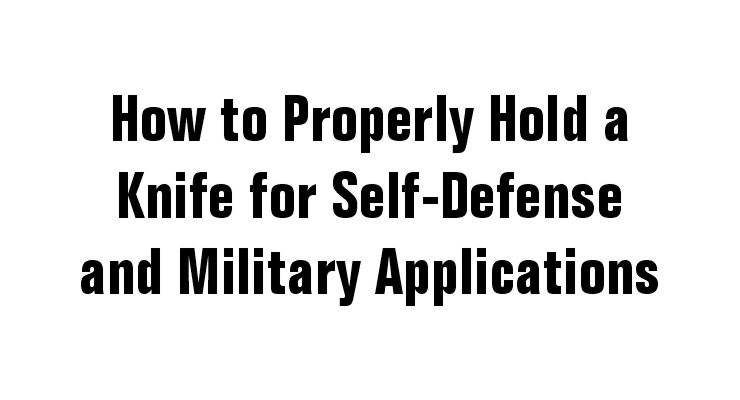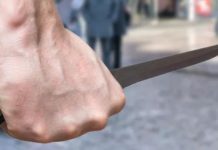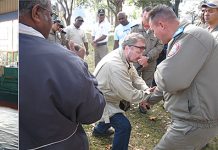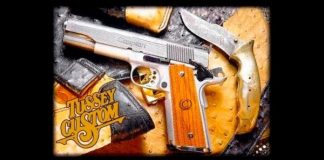The author of this article is WR Mann. He is the founder and publisher of Defense Science. He was one of the early advocates of Reality-Based Training, developing one of the first RBT programs before most people even knew what the term meant.
Of the innumerable knife concepts and maneuvers that I consider unsound, the most egregious of these are the unsafe knife grips that abound. They have been so entrenched in the knife culture that even many experts are confused.
The purpose of this article is to elucidate edged weapons neophytes i.e. civilians, LE and military operatives about the perils of using unsafe knife grips. My responsibility as a defensive tactics instructor is to teach proper safety protocols to individuals who need to use a knife to protect their lives.
Get a Grip – Get a Good Grip!
Unquestionably, the most important part of the knife is the handle, the grip is the interface between the knife and the user. Yet for decades a profusion of risky grips have been taught and even fostered as a matter of course from both Asian and Western lineages. It’s absolutely astonishing that so many students and practitioners of the knife would blindly follow an approach that can easily hurt them and potentially get them killed.

Collection of Unsafe Grips
Anyone can clearly see that the photos above represent dangerous grips, and that they can certainly lead to serious injuries. So what constitutes an unsafe grip? The simple answer is any grip where all the fingers are not fully wrapped around the handle. (there are a few minor exceptions and these will be addressed in Part II of this article).


Filipino Grip – Cuts your Fingers Forefinger on Spine – Lose the Knife
Examples of dangerous grips include posting the thumb or forefinger atop the knife spine, or – one or two fingers floating off the knife handle, or – the last 2 – 3 fingers are the only ones maintaining contact with the handle.

2 Grips – Present a Great Way to Injure your Hand & lose Your Knife

Whittling Grip – The easiest way to cut your hand and lose your knife
So – do any these unsafe grips work at all? Well, if the assailant would just have the decency to stand still and allow the defender to stab him, then these grips would work brilliantly. However, some attackers have been known to not comply and instead move around erratically. Yes, there is always the luck factor – that may work, and then there is that one percentile that can do anything. There are a handful of highly skilled instructors I respect, and they are exceptions to this rule, but for the rest of us, wouldn’t it be more prudent to establish a secure grip?
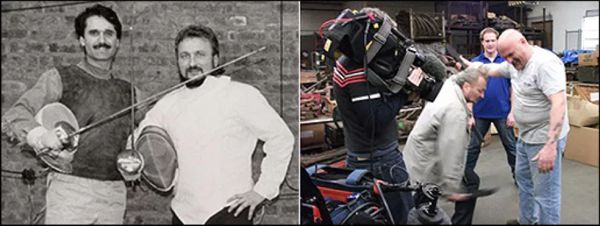
Sabre and Epee at Santelli’s NAT/GEO Doc. The Bowie Knife
Having a background in fencing as well as Asian and Western knife systems, I have taught tactical knife skills worldwide to military, law enforcement and government agencies for years. I invariably come across students who are confident with their risky grips – but while sparring (with training knives) they often lose their knives, or would have been severely injured if the training knives had sharp edges.
The Non-Believers
There will undoubtedly be more than a few individuals in the knife community that will howl in protest and claim that these grips have a valid purpose, however when questioned they usually respond with: 1) It’s tradition, my teacher told me to hold it this way, 2) I use these affectations because they make me look cool, 3) I can’t admit I was wrong all these years, what would my students think, 4) These grips are battle proven (says who?) and then there are those classics, “oh well, little grasshopper you don’t truly fathom the depth of our art.”


How Do Knife Attacks Occur?
Many knife attacks are often ambushes and surprise attacks, you never know what kind of edged weapon will be used against you. It could be a machete, a folder or even a box-cutter, and most likely you won’t be able to get to your weapon forthwith. Nevertheless, if you are able to deploy your weapon in time, the immediate objective is to stop the attacker.
The most expeditious way to do that is with a thrust(s). Slashing with a knife in many cases will not shut down an attacker – and here is where the problem of a risky knife grip presents itself. In a heated battle – fully adrenalized, all of the force is generated onto the knife handle; this is the critical point. If the attack is intense, as most are, you may hit an unyielding object such a hip or a belt and that three-finger grip would most assuredly not serve you well.
This is not mere speculation on my part but is evidence based. Law enforcement officers and medics from many countries have often confided in me about severe knife related injuries to the defender they have witnessed in the aftermath of a violent engagement.

These have ranged from severe cuts to the hand and/or losing fingers. After investigating the incidents and speaking to the victims it was determined that many of these injuries were the result of three factors: 1) Wounds from the attack, 2) the hand slipping down the blade after hitting a hard object, and 3) A folding knife closing on the fingers. Two of these causes can be avoided through knowledge and training.

Hand Sliding Down Blade After Hitting a Hard Object

Folding Knife Closing on Fingers After Hitting a Hard Object

Consequences of Using an Unsafe Grip
The Continuum of Confusion
Without doubt, modern knife grips were derived from the sword (or bolo in SE Asia). The most influential sources that emerged were from America, Europe and South East Asia. However, that doesn’t mean they have any inherent value, it just means the sword was incorrectly used as a pattern for their knife grips (A more exhaustive study of how knife grips evolved is featured in Part II of this article).
So Who Are the Experts at Cutting Meat?
For a longest time, my quest was to discover the safest and effective way to grip the knife. Having speculated about this for years, I finally arrived at my eureka moment! The one group that exemplifies cutting meat in the most efficient and safest manners – the butchers. They do it day after day – year after year – who better to ask?

Butchers Cutting Meat
Over the course of several years I visited various butchers, slaughterhouses and meat purveyors and inquired if they ever cut meat holding their knives in a style that resembled some of the popular knife grips used in Asian and Western combative knife styles.
Well, once they got off the floor howling with laughter, they explained that the only time they would ever post a thumb or finger on top or to the side of a blade was if they were cutting very thin slices of meat (the purview of chefs) – however for day-to-day cutting, it was “all fingers aboard.”
Now, it’s also important to realize that when butchers cut meat, the meat doesn’t move, it lays still, however when a crazed attacker rushes towards you with a weapon he is adding a factor of force, the defender also adds a factor of force, and during this unpredictable melee the last thing you want is to lose your knife.
Since no one outside the medical community genuinely understands how the hand and grip functions, especially while holding a knife, I have elicited help from an expert on the subject, a noted NY hand surgeon, see below.
Article by Defense Science
BIOMECHANICS OF THE HAND
By Jacques Henri Hacquebord, MD
The incredible dexterity of the human hand far exceeds that of other primates. Many people will be incorrectly taught that the difference is due solely to the opposable thumb. While the human thumb is an invaluable asset to the functioning of our hands, it is only part of the picture. Almost equally as vital as the thumb is the mobility of the ulnar sided digits (ring and small fingers). One can appreciate this when cupping one’s hands e.g. to scoop sand or water into the hand.
When dividing the hand into parts based on mobility, there exist three parts: two mobile and one immobile. The thumb, as we already know, is highly mobile and allows for opposition all the way to the small finger. The middle portion of the hand (index and middle fingers) is very stable and allows for only flexion and extension of these two fingers. The ring and small fingers form the third part and is mobile as well. These features of the hand are essential for normal functioning.
When gripping something firmly (what is referred to as the “power grip” in hand surgery), all five digits are absolutely essential for maximal strength. The index and middle fingers form the stable post that flexes around the object. The thumb and ulnar side of hand are the two mobile portions that then wrap around and because of their ability for opposition, squeeze the object against the stable post created by the middle and index fingers. This is something that we naturally do and are not required to be taught.
For example, when doing pull-ups, how do you hold the bar? Of course, you hold it by wrapping all four fingers around the bar and the thumb around the other direction. What you most likely never noticed though was that the small and ring fingers don’t just flex around the bar, but also squeeze in towards the base of the thumb.
If you want to experience that mobility yourself, look very carefully at your hand when you have the fingers fully extended (straightened) and then slowly bring it to a full and tight fist. If you squeeze the small and ring fingers even tighter, you will notice that it moves a little farther down than the middle and index fingers. It is this feature of the small and ring fingers that enable the grip strength to be maximized and to create the “power grip”.
When holding an object, such as a knife handle for fighting purposes, it is essential to have full maximal grip strength. This maximal grip strength can only be obtained when all five digits work in this coordinated manner; the thumb wraps around and over the index/middle fingers and the ring/small fingers squeeze down tightly.

Power Grip – Standard Orientation Power Grip – Reverse Orientation
Holding the object in any way other than a power grip significantly decreases the grip strength. For example, when the thumb or ring/small fingers are not appropriately utilized the grip strength is significantly compromised. It is for these reasons that the power grip is the only appropriate way to hold a knife handle when used for fighting purposes.
MISCONCEPTIONS:
Patients often ask me, after the thumb, which digit is the most important. It is well known in the hand surgery community that the index finger is the most dispensable. However, this doesn’t mean that the index finger isn’t very important. It just means that if the index finger is lost, the remaining digits can compensate relatively well.
When holding a knife handle, I have seen some people teach that the index and middle fingers are nonessential and that only the ring and small fingers are needed for a firm grip. This teaching is completely false. For the strongest grip, the index and middle fingers are absolutely essential. As described above, the index and middle fingers form a stable platform against which the mobile thumb and ulnar digits can compress. Furthermore, extending the index and middle finger puts these two fingers at very high risk of injury.

Grip Held by 3-Fingers Grip in Blade Up Orientation
If either the thumb or index finger is held off of the knife handle, there is a significant risk that the user will lose control of the knife and even cause an accidental self-inflicted injury.

Thumb on Spine Grips in Standard Formation
Another common and incorrect teaching is to place the thumb on top of the spine of the knife (see picture). For all of the reasons already discussed, this is not a secure grip. This puts the individual at significant risk of getting the knife knocked out of their hand and/or sustaining accidental and self-inflicted lacerations.
CONCLUSION:
With an understanding of the basic biomechanics of the hand, there is no debate that the power grip consists of using all 5 digits in the described coordinated manner. Furthermore, it is clear that this allows for the strongest grip and maximizes the strength with which the knife handle is held.
Article by: Jacques Henri Hacquebord, MD
Assistant Professor of Orthopaedic and Plastic Surgery
New York University School of Medicine
Division of Hand Surgery, NYU Hospital for Joint Diseases
Co-Chief, Hand Surgery Service, Bellevue Hospital Center

Contact WR Mann and Defense Science on the Martial Arts Schools and Businesses Directory by clicking on the image above.

